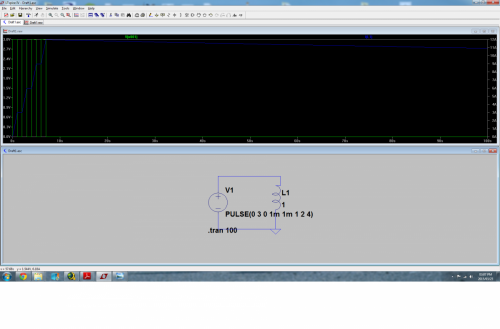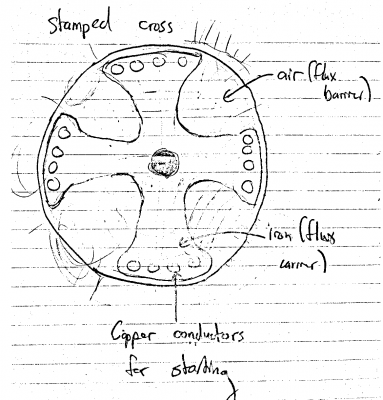

CasualKilla
Senior Members-
Posts
178 -
Joined
-
Last visited
Content Type
Profiles
Forums
Events
Everything posted by CasualKilla
-

Magnetic field lines and iron filings
CasualKilla replied to CasualKilla's topic in Classical Physics
Looks like my "blob" predictions was near the truth, but did not consider how much stronger the field is near the poles, so naturally the filing gather there first. we can still see some N-N, S-S attraction, but it is not as intense as expected. For some reason none of these plebs leave the video on long enough to see the final steady state formation -

Are you smart enough to you solve mysterys of the electromagnet?
CasualKilla replied to CasualKilla's topic in Engineering
That is indeed very interesting, it helps explain the behaviors of those iron filings. I would still love to see the behavior of iron filing in a 0 g environment. I still think your explanation of the like pole repulsion makes sense, the more Iook at iron filing structures the more it makes sense. it explains why some cluster are thinker than other like below. But it is somewhat misleading and redundant, since if I measure a constant field around the conductor I cannot conclude anything other than no varying current inside the conductor. I still have no idea how much current, or if there is any at all.. -

Spice simulation, was is the current dropping?
CasualKilla replied to CasualKilla's topic in Engineering
That is very interesting, I would have thought it would inforce the source voltage. -
Yes that is 100% right, you create an opposite angular momentum on the earth when you spin it up, then the angular momentum returns to the initial value after the wheel stops spinning. You can also show that a torque is created on the earth by the friction which is what transfers the impulse. Bonus marks for anybody who can give a estimate of the change of angular momentum of the earth while the wheel is spinning. Make some realistic estimates for the wheel mass and angular velocity!
-
That answer is weak-sauce, you can do better. It depends on the boundary's you choose yourself. Technically the only truly closed system is the entire universe, make some approximations.
-
1 right answer and 1 wrong answer so far, so tense
- 40 replies
-
-1
-
Like somebody stated, magnetism is a relativistic effect of the electric field, and electrical field are produced by electrical charges. What is an electric charge, and why does it create an electric field, that is difficult to answer since it is not something that was derived, but rather something be observed. it is rather cool that we can reduce electricity and magnetism down into two ideas, the electric charge and relativity. If electric field could be described by bending of space-time like gravity is would all fit together nicely, but then again we don't know why mass bends space-time, only that is does. Though some quantum groupies might disagree with me.
-
Please refer to the spinning skateboard wheel in the video below. Those of you with the patience to watch it to the end will notice the wheel does indeed stop spinning. Why question to you is why does the wheel stop spinning, more specifically how is the angular momentum be conserved if the wheel stops spinning? Saying friction causes the wheel to lose kinetic energy true, but does not explain how momentum is conserved. GL
-
The resistance of the source and inductor are set to 0, this must be a mistake right? I was expecting current to stay constant after the source stops pulsing.
-

Are you smart enough to you solve mysterys of the electromagnet?
CasualKilla replied to CasualKilla's topic in Engineering
I think i finally get it now. Some doofus on youtube was going on about symmetry in Maxwell's equations, but I don't see it. Statements like "if a wire a constant current inside it, it has a constant magnetic field around it, similarly if a wire has a constant magnetic field around it, it must have a constant current inside it" are simply untrue, and which lead to my intuitive misunderstanding. -

Understanding the RSM (reluctance synchronous machine)
CasualKilla replied to CasualKilla's topic in Engineering
Please tell me your joking.. You mock me for posting easy puzzles, but you really proposing reluctance synchronous machines do not exist. enjoy: http://www.abb.com/product/seitp322/c347a19269e8ad4ac125785b00217276.aspx?productLanguage=us&country=ZA -

Are you smart enough to you solve mysterys of the electromagnet?
CasualKilla replied to CasualKilla's topic in Engineering
I get that now since the induced EMF breaks Kirchhoff law, but what about Ampere's law, it seems to indicate that a constant current corresponds to a constant H field, or that also "induced H field" in this case? -

Are you smart enough to you solve mysterys of the electromagnet?
CasualKilla replied to CasualKilla's topic in Engineering
That is just not right. A constant current produces a constant magnetic field and a constant voltage produces a changing magnetic field. In the case of a super conductor, you can produce a constant magnetic field with zero voltage. Poop, I think your right about the voltage though.. Since the closed loop integral of an inductor circuit is 0, I do not think it will produce changing flux. Conservative field and so on One thing still confuses me though, why does a constant current around a solenoid produce a constant magnetic field inside it, apllying a constant magnetic field inside the solenoid does not produce a constant current. Makes sense from a practical point of view since we could just get free energy from wrapping coils around magnets, but don;t know how to reconcile it with amperes law. -
That is why scientists originally thought that the universe was infinite and eternal. Astronomers looked to the sky for signs of the universe slowing contracting, but they discovered that it was in fact expanding at an accelerating rate. From there they extrapolated the big bang. The simplest solution is not always right, I would never use Occam's Razor to measure the validity of theories, though it can be a useful rule of thumb.
-
Why would there be something rather than nothing? Intuition tells us thatoriginally there must have been nothing, therefore something must have came from nothing, but this may not be true, perhaps there was something in the beginning. If we assume that there was indeed nothing before there was something, then the conclusion is that somethingness must be more stable than nothingness. Perhaps nothing can split into two polar opposites that can be combined again to form nothing. Perhaps mass and anti-mass, energy and anti-energy. Quantum physics is already showing signs that the vacuum is not quite empty and static. Particles and "anti-particles" are constantly coming into existence, but then recombining to form "nothing". Even if the theory above does not pan out, i don't believe we should attribute the somethingness to supernatural causes because we are unable to understand the concept of something appearing from nothing, we much push forward to develop and test new theories that may explain this non-intuitive phenomenon. TLDR: Nothingness is unstable.
-

Are you smart enough to you solve mysterys of the electromagnet?
CasualKilla replied to CasualKilla's topic in Engineering
Correct, well done sir. -

Are you smart enough to you solve mysterys of the electromagnet?
CasualKilla replied to CasualKilla's topic in Engineering
YES and NO!! Yes you will need a closed conductive circuit, but change in flux depends only on the voltage across the coil. Faraday's Law always holds. Actually not sure if you even need a closed circuit, but good luck applying a voltage to the coils without one. Edit: Wait I think you are wrong, I don't think you need current at all. -

Are you smart enough to you solve mysterys of the electromagnet?
CasualKilla replied to CasualKilla's topic in Engineering
Yes, and also a voltage induces changing flux, so why does the magnet have constant strength, it should be increasing right? -

Understanding the RSM (reluctance synchronous machine)
CasualKilla replied to CasualKilla's topic in Engineering
LOL, we are in the same boat bud, I don't know how it works, but it does. XD. You are still thinking about switched reluctance machines, which work differently on the stator side. have a look at this video: https://www.youtube.com/watch?v=XuwV5dSvjh4. It is not very technical, but it will atleast prove to you it is a thing. and here is a video by ABB: https://www.youtube.com/watch?v=69mtuom774E. -

Permanent magnet thought experiment, help with hypothesis.
CasualKilla replied to CasualKilla's topic in Engineering
Gonna start with "M.I.T.-Walter Lewin- Complete Breakdown of Intuition - Part1" since that how I am have been feeling after deciding to study electromagnetism. lol -

Permanent magnet thought experiment, help with hypothesis.
CasualKilla posted a topic in Engineering
If we placed some conducting coils inside a magnetic field created by 2 permanent magnets, Ampere's law tells us that the current in those coil will be proportional to the flux flowing through the coils. This is fine if the coil is a super conductor, but as soon as you add a resistor to the coils, the current will create a potential across the resistor and thus the coils. Faraday's law tells us this will produce a changing flux, in this case the flux in the core will reduce. This seems to lead to an odd conclusion, either the permanent magnet strength must decrease to reduce the flux or the core must become extremely resistant to flux at steady state. My money is on case 2, but it still seems very weird since reducing the magnetic field to 0 would create a magnetic Faraday cage, or what I shall name CasualKilla Cage . -
Anybody can tell you that if you wrap some wires around a something then pass a current though it, you will make an electromagnet, but did a single one of you stop to consider what was actually going on? Faraday's Law tells us that is we apply a voltage to this coil, the flux within the coil will increase with time. Consider a voltage being applied directly to a coil, well this should produce a ever increasing strength magnet right? But we know that DC electromagnets create a constant strength magnet. I sure as hell haven't heard of somebody creating some kind of magnetic singularity in their basement. So who can tell me why a DC electromagnet creates a constant strength magnet field? I figured out the answer myself, so only reply if you wanna show of your mad intellect.
-

Understanding the RSM (reluctance synchronous machine)
CasualKilla replied to CasualKilla's topic in Engineering
That is a switched reluctance motor, and it has some crazy stuff going on in the stator, stuff that I am not smart enough to even consider. The diagrams I posted are Reluctance Synchronous Machines, which use the same stator as an induction motor. I had a discussion with one of my lecturers about this, and I asked him, why can you not just use some kind of cross for the rotor (4 pole). (This is the one of my original, now discarded designs below) But the above design will not work in a IM stator. I am not 100% sure why, but I think it is because the flux is deliver through discrete teeth and in the above design all the flux entering into those massive air gaps will be wasted. This is what a modern existing design looks like, courtesy of ABB: -
So you cant have an E-field like I have drawn since you need to consider that that E-field will need to be created by some voltage source, which will make the curl 0? So my understanding of the curl was correct, but my understanding of the E-field was fundamentally flawed. Also that E field as I drew it only exists at a single point in the z and y plane, how would you compute the partial derivatives for that, it is like a piece wise vector function. My vector algebra is ok since we calculate vector current and voltage for circuits, though this is 2 dimensional. All I know about vector calculus I have thought myself, but I have a good understanding of partial derivatives.






